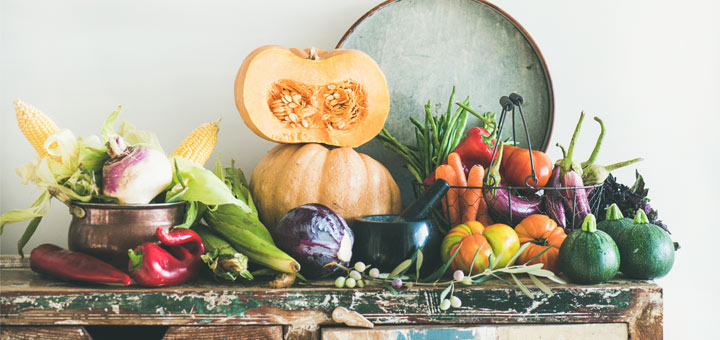If the crisp air and golden-brown leaves didn’t clue you in, the addition of pumpkin spice lattes to coffee shop menus signal that fall is underway. Fall isn’t just about pumpkin-flavored foods and beverages, though. As you move further into the autumnal months, you start to see an assortment of fresh, fall produce in grocery stores. In addition to being hardy and nutrient-dense, many fall produce items burst with flavor.
According to the Cleveland Clinic, a diet that incorporates fall fruits and vegetables, along with whole grains and legumes, supports a healthy heart. A 2020 study found that vegetarians who ate a diet rich in nuts, vegetables, and soy, experienced a lower risk of stroke than non-vegetarians who ate meat. Hopefully this incentivizes people to veg out from now on, especially on the fruits and vegetables detailed in this article.
Shopping and cooking with seasonal ingredients is better for your health and the environment. The reason for this is because seasonal produce is at peak freshness and nutritional value, and typically from local farmers. This helps to reduce carbon footprint because not as much transportation is required to get the produce from the farm to your local grocery store. Depending on where you live, you may see different fall fruits and vegetables, but these are some of the best ones to eat no matter where you are.
Eggplant
This low-calorie nightshade is a great source of fiber, antioxidants, vitamins, and minerals, especially potassium and vitamin B6. Eggplant is rich in anthocyanins, a type of pigment with antioxidant properties that give eggplant the signature purple hue. Nasunin, an anthocyanin in eggplant, may be effective at protecting cells against free radical damage. Adding more eggplant to your diet may also help decrease your risk of heart disease and improve blood sugar control.
Brussels Sprouts
One cup of cooked Brussels sprouts contains 14% of the daily value (DV) of fiber. There is also a lot of evidence that indicates that these cruciferous vegetables may aid in your fight against cancer. Researchers attribute ability this to the glucosinolates in Brussels sprouts, which have cancer-preventative properties. Brussels sprouts may just be one of fall’s most underrated treats, and you can cook them or enjoy them raw.
Cauliflower
Even though your mom always told you to eat green vegetables, you shouldn’t avoid cauliflower because of the bland color. Cauliflower happens to be an excellent source of fiber and potassium, two nutrients that aid with blood pressure regulation. Shockingly, most American adults don’t meet the recommended daily intake of either nutrient, but eating cauliflower can fight that statistic. Cauliflower is also an excellent source of vitamin C, which stimulates collagen production and enhances immune function.
Winter Squash
Don’t let the name fool you because “winter squash” is the umbrella term for squash harvested in the fall. Winter squash varieties include spaghetti squash, butternut squash, acorn squash, and more. Not only are these squash varieties rich in flavor and hardy, but they also provide lots of beta-carotene, magnesium, potassium, and fiber. According to food data, there are 5,920 micrograms (mcg) of beta-carotene in one cup of butternut squash. Beta-carotene is a plant pigment that the body converts to vitamin A, which is beneficial for immunity and eye health. Additionally, vitamin A supports healthy kidney, heart, and lung function, so get your dose of winter squash this fall.
Artichokes
Unfortunately, many people eat artichokes in the unhealthiest way possible: in spinach artichoke dip. This dairy-rich, fattening appetizer has zero nutritional value from the artichoke or spinach. You can steam or grill artichokes, seasoning them with sea salt, garlic, pepper, olive oil, and lemon juice. Several studies indicate that, gram for gram, they contain more antioxidants than any other vegetable.
Pears
People often overlook pears for some odd reason, despite their juicy, sweet flavor profile. Nutritionally, they are similar to apples, but they have more fiber. A medium pear offers about 20% of your DV of fiber, and it only is 101 calories. A small 2019 study monitored participants with metabolic syndrome, diabetes, high blood pressure and obesity. The participants ate two pears daily and were able to improve heart health and other markers of good health. Researchers noted that the fiber played a large role in this, as diets rich in fiber are linked to reduced risk of heart disease.
Cranberries
Cranberries are only in season for a short while, so get your hands on them while the gettin’s good. They have a bright red hue and may be the quintessential fruit of fall. Just like eggplant, cranberries have anthocyanins that work to reduce oxidative stress in the body. This is very important because too much oxidative stress in the body increases the risk of Alzheimer’s disease and diabetes. One study found that participants who took a daily cranberry supplement (equating to one cup of cranberries) for twelve weeks experienced improved memory and lower LDL cholesterol. Dried cranberries are readily available, but the nutrients lie in the fresh varieties.

Vincent Stevens is the senior content writer at Dherbs. As a fitness and health and wellness enthusiast, he enjoys covering a variety of topics, including the latest health, fitness, beauty, and lifestyle trends. His goal is to inform people of different ways they can improve their overall health, which aligns with Dherbs’ core values. He received his bachelor’s degree in creative writing from the University of Redlands, graduating summa cum laude. He lives in Los Angeles, CA.

























